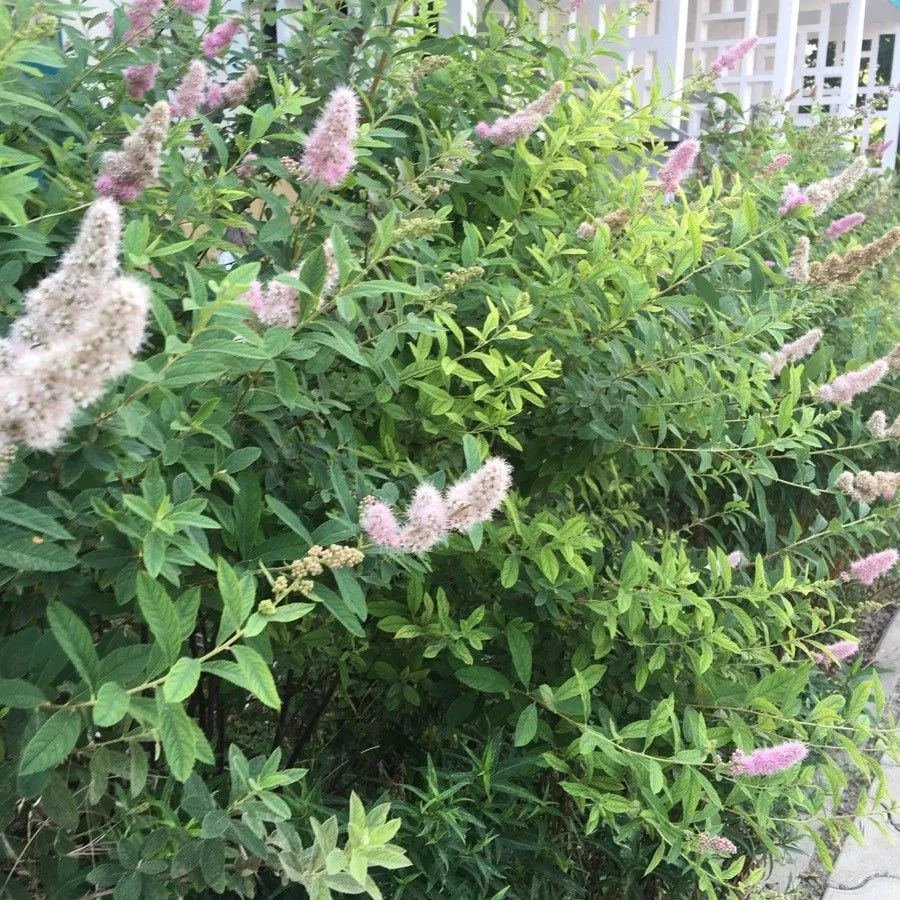
Author: L.
Bibliography: Sp. pl. 1:489. 1753
Year: 1753
Status: accepted
Rank: species
Genus: Spiraea
Vegetable: False
Observations: EC. Europe to N. & C. Japan
The Bridewort, scientifically known as Spiraea salicifolia, is a captivating member of the Rosaceae family. This elegant plant has been recognized in botanical circles since its initial classification and description by Carl Linnaeus in 1753.
Boasting a widespread geographic range, Bridewort is native to regions extending from Eastern and Central Europe to Northern and Central Japan. This broad distribution is a testament to the plant’s adaptability and resilience in various climatic and soil conditions.
Bridewort is particularly noted for its beauty, often admired for its clusters of small, delicate flowers that usually bloom in late spring to early summer. These blossoms, typically white or pink, have a frilly, airy appearance that makes the plant a popular choice for ornamental purposes in gardens and parks. The foliage, resembling willow leaves, adds to its charm, contributing to the plant’s graceful and light aesthetic.
Besides its ornamental value, Spiraea salicifolia has found its place in traditional uses and eco-gardening. The plant’s sturdy nature and dense growth make it an excellent choice for creating natural hedges, offering privacy as well as habitat for various birds and insects.
In summary, Bridewort (Spiraea salicifolia) is not just a plant of historical significance and botanical interest but also a delightful addition to both wild and cultivated landscapes. Its delicate flowers and robust growing habits ensure that it continues to be a favorite amongst horticulturists and garden enthusiasts alike.
Eng: bridewort, willowleaf meadowsweet, willow-leaved meadowsweet, willow spiraea
Dan: pilebladet spiræa
Ita: spirea con foglie di salice
Fra: spirée à feuilles de saule
Deu: weiden-spierstrauch, weidenblättriger spierstrauch
Hun: fűzlevelű bajnóca
Nob: hekkspirea
Nno: hekkspirea
Swe: häckspirea
Fin: pajuangervot
Ces: tavolník vrbolistý
Nld: theeboompje
Cym: erwain dail helyg, erwain helygddail
En: Bridewort, Willowleaf meadowsweet, Willow-Leaf Meadowsweet, Willow-leaved meadowsweet, Willow Spiraea, Willow-leaved Spirea
Zh: Liu ye xiu xian ju
Cs: Tavolník vrbolistý
Da: Pilebladet spiræa
Nl: Theeboompje
Fi: Viitapajuangervo, Pajuangervot
Fr: Spirée à feuilles de Saule
De: Weiden-Spierstrauch, Weidenblättriger Spierstrauch
Hu: Fűzlevelű bajnóca
It: Spirea con foglie di Salice, Spirea a foglie di salice
Nb: Hekkspirea
Nn: Hekkspirea
Sv: Häckspirea
Cy: Erwain Dail Helyg, Erwain Helygddail
Taken Sep 24, 2020 by Ludo Didden (cc-by-sa)
Taken Sep 21, 2019 by Garden Dad (cc-by-sa)
Taken Jul 21, 2021 by Sabina Hartmann (cc-by-sa)
Taken Aug 17, 2017 by Agnieszka (cc-by-sa)
Taken Aug 14, 2022 by Goodman Miles (cc-by-sa)
Taken Jul 11, 2022 by Sabina Hartmann (cc-by-sa)
Taken Jun 18, 2022 by Jacques Zuber (cc-by-sa)
Taken Aug 2, 2021 by DH Sol30 (cc-by-sa)
Taken Jun 16, 2019 by Anastasia Getman (cc-by-sa)
Taken Jul 21, 2021 by Sabina Hartmann (cc-by-sa)
Taken Aug 2, 2021 by DH Sol30 (cc-by-sa)
Taken Sep 3, 2015 by Tela Botanica − Alain BIGOU (cc-by-sa)
Taken Sep 3, 2015 by Tela Botanica − Alain BIGOU (cc-by-sa)
Taken Jun 16, 2019 by Anastasia Getman (cc-by-sa)
Taken Jul 21, 2021 by Sabina Hartmann (cc-by-sa)
Taken Mar 28, 2021 by Maarten Vanhove (cc-by-sa)
Taken Jul 15, 2021 by cirse (cc-by-sa)
Taken Jul 13, 2022 by Bram W (cc-by-sa)
Taken Jun 9, 2022 by B K (cc-by-sa)
Taken Jul 30, 2022 by Waldemar Zeja (cc-by-sa)
Taken Jul 7, 2020 by Yvon Red (cc-by-sa)
Taken Nov 10, 2020 by Palo Rapos (cc-by-sa)
Taken Jul 3, 2020 by Oli Haill (cc-by-sa)
Taken Jul 30, 2022 by Waldemar Zeja (cc-by-sa)
© copyright of the Board of Trustees of the Royal Botanic Gardens, Kew.
© copyright of the Board of Trustees of the Royal Botanic Gardens, Kew.
© copyright of the Board of Trustees of the Royal Botanic Gardens, Kew.
Growth habit: Shrub
Ph maximum: 7.0
Ph minimum: 6.5
Light: 7
Atmospheric humidity: 5
Soil nutriments: 6
Family: Myrtaceae Author: (F.Muell.) K.D.Hill & L.A.S.Johnson Bibliography: Telopea 6: 402 (1995) Year: 1995 Status:…
Family: Rubiaceae Author: Pierre ex A.Froehner Bibliography: Notizbl. Bot. Gart. Berlin-Dahlem 1: 237 (1897) Year:…
Family: Sapindaceae Author: Koidz. Bibliography: J. Coll. Sci. Imp. Univ. Tokyo 32(1): 38 (1911) Year:…
Family: Asteraceae Author: A.Gray Bibliography: Pacif. Railr. Rep.: 107 (1857) Year: 1857 Status: accepted Rank:…
Family: Fabaceae Author: Medik. Bibliography: Vorles. Churpfälz. Phys.-Ökon. Ges. 2: 398 (1787) Year: 1787 Status:…
Family: Aspleniaceae Author: (Cav.) Alston Bibliography: Bull. Misc. Inform. Kew 1932: 309 (1932) Year: 1932…